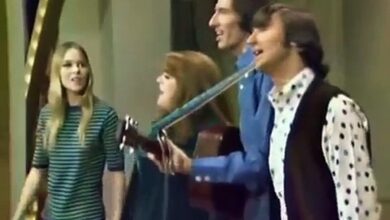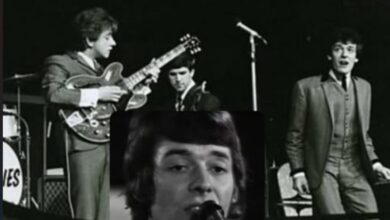The Monkees’ “I’m a Believer” Captures Pop Perfection and Redefines Success in 1966
When The Monkees released “I’m a Believer” in late 1966, it quickly became one of the most defining songs of its era, achieving unprecedented commercial success and reinforcing the power of television-driven pop culture. Written by a young Neil Diamond, the song topped the Billboard Hot 100 for seven consecutive weeks, ultimately becoming the best-selling single of 1967. It wasn’t just another hit; it was a cultural phenomenon that blurred the lines between a TV creation and legitimate musical artistry.
The Monkees, originally formed as a made-for-television band for NBC’s sitcom of the same name, were composed of Davy Jones, Micky Dolenz, Michael Nesmith, and Peter Tork. Although critics initially dismissed them as a manufactured group, the members were talented performers with strong musical instincts. Micky Dolenz’s charismatic vocals and the group’s natural chemistry set them apart from other pop acts, allowing them to evolve beyond their TV origins into a bona fide musical force.
The story behind “I’m a Believer” begins with songwriter Neil Diamond, who was still in the early stages of his own career. He penned the upbeat tune with a blend of pop hooks and lyrical innocence that perfectly matched The Monkees’ image. Originally intending to record it himself, Diamond instead passed the song to The Monkees at the suggestion of producer Jeff Barry. The result was a collaboration that changed the course of pop music history.
The recording of “I’m a Believer” was handled by seasoned session musicians from the Wrecking Crew, under the production of Jeff Barry. While the instrumental backing was pre-recorded, it was Micky Dolenz’s energetic and joyful lead vocals that gave the song its heart. The production leaned heavily on infectious organ riffs, jangly guitars, and a driving beat, crafting a sound that was both radio-friendly and instantly memorable. The final version captured a sense of uncontainable excitement that defined much of 1960s pop.
Upon its release in November 1966, “I’m a Believer” became an immediate sensation. It shot up the charts at lightning speed, eventually securing the number one position on Billboard’s Hot 100 by December. Its reign at the top lasted through the start of 1967, and the song remained in the Top 40 for over three months. Internationally, it also reached number one in countries like the United Kingdom, Canada, Australia, and Ireland, affirming The Monkees’ global appeal.
Culturally, “I’m a Believer” proved to be more than just a hit song. It shattered preconceived notions about what a television band could achieve in the music industry. The Monkees, often labeled the “Prefab Four,” showed that their music could stand on its own merits. The success of the single, combined with their popular TV show, helped democratize pop stardom, suggesting that charisma, mass media presence, and genuine musical talent could coexist successfully.
The enormous popularity of “I’m a Believer” elevated The Monkees’ career to new heights. They embarked on sold-out tours, released hit albums, and began to demand greater creative control over their recordings. Their ability to transition from scripted television performers to respected musicians was largely anchored by the credibility and momentum that “I’m a Believer” provided. It opened the door for them to later write and perform their own material, marking an important evolution in their artistic journey.
The ripple effects of the song extended beyond The Monkees themselves. It influenced countless aspiring musicians who saw the power of catchy songwriting coupled with mass media exposure. “I’m a Believer” became a template for future pop acts aiming to blend music with television, paving the way for later phenomena like The Partridge Family and even influencing the strategies behind MTV-driven acts in the 1980s.
Numerous artists have covered “I’m a Believer” over the years, most notably Smash Mouth’s 2001 rendition for the Shrek soundtrack, which introduced the song to a new generation. While Smash Mouth’s version leaned into a more rock-oriented sound, it retained the exuberance and universal appeal of the original. The enduring popularity of covers across decades underscores the timeless quality of the melody and the sheer joy embedded within the song’s structure.
At the time of its release, The Monkees were riding a wave of massive commercial success, but there were also tensions behind the scenes regarding their musical autonomy. The triumph of “I’m a Believer” gave them the leverage to fight for and eventually win more control over their recordings, leading to projects like the Headquarters album, which featured the band playing their own instruments without outside studio musicians.
Today, “I’m a Believer” remains a staple of oldies playlists and classic pop retrospectives. Its infectious chorus, optimistic lyrics, and buoyant spirit have ensured its place as one of the quintessential songs of the 1960s. It consistently ranks high on lists of the greatest pop songs of all time and is often cited as one of the best examples of how a single track can capture the imagination of an entire generation.
In looking at its broader impact, “I’m a Believer” helped cement the idea that pop music could be both commercially driven and genuinely heartfelt. The production techniques, with their layered instrumentation and radio-polished finish, would influence future generations of pop producers looking to blend accessibility with musical sophistication.
While The Monkees’ career would evolve and change in the years that followed, the success of “I’m a Believer” established them not merely as TV characters but as genuine artists with lasting cultural significance. The song remains a reminder that sometimes the most enduring pieces of music are those that combine simple, heartfelt sentiments with irresistible melodies.
Ultimately, “I’m a Believer” is more than a chart-topping hit; it’s a symbol of an era when pop music, television, and youth culture collided to create something bigger than any of its parts. Decades later, it still sparks sing-alongs and smiles wherever it plays—a timeless reminder of The Monkees’ unique place in music history.





